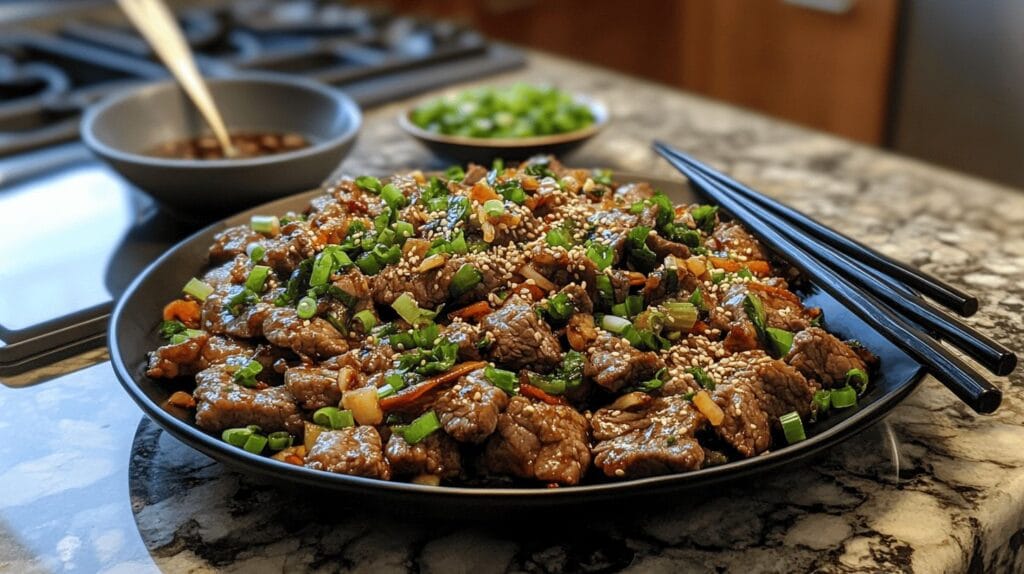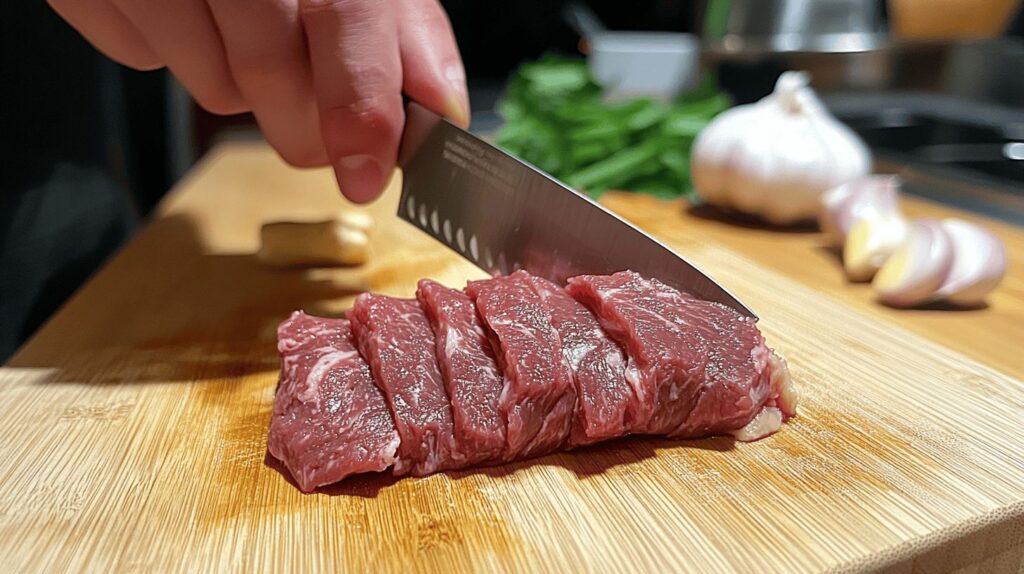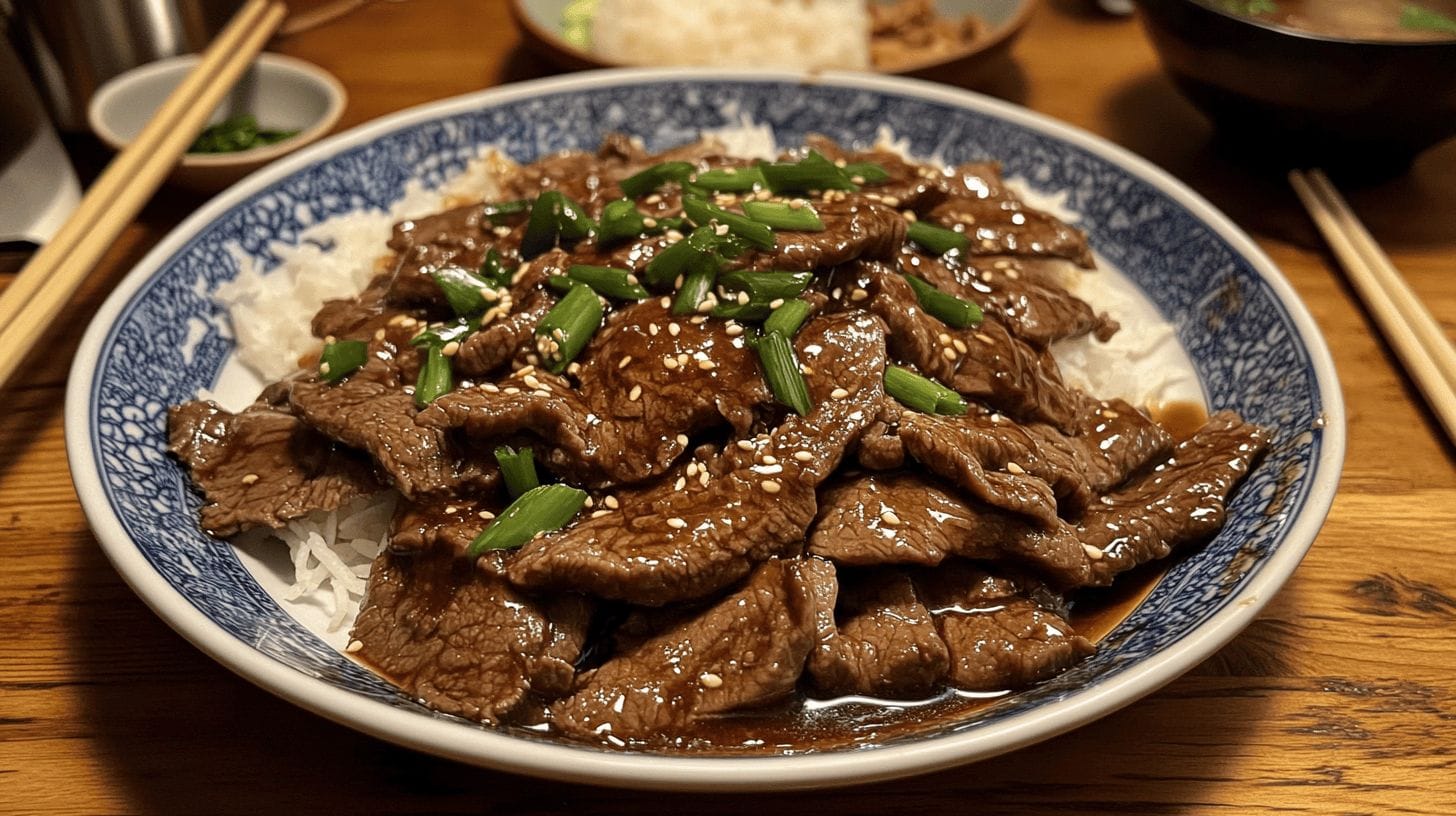Table of Contents
Mongolian beef is one of those dishes that leaves you wondering, “How is it so tender every single time?” If you’ve ever dived into a plate of Mongolian beef and marveled at its melt-in-your-mouth goodness, you’re not alone. But what’s the secret behind this culinary magic? In this article, we’ll explore everything from the preparation techniques to the science of tenderness. Let’s dig in! 🍽️
Introduction to Mongolian Beef
What is Mongolian Beef?
Mongolian beef is a classic dish often found in Chinese-American restaurants. Despite its name, the dish isn’t Mongolian by origin. It features thinly sliced beef stir-fried with a sweet and savory soy-based sauce, often paired with green onions and served over steamed rice or noodles.
The Origins of Mongolian Beef
So, why the name “Mongolian beef”? The dish draws inspiration from the Mongolian hot pot cooking style, where thinly sliced meats are cooked quickly over high heat. While it’s not authentically Mongolian, it embodies the bold flavors and quick preparation that are hallmarks of Asian cuisine.
Popularity of Mongolian Beef Worldwide
With its rich flavors and approachable ingredients, Mongolian beef has gained global popularity. Whether you’re at a fancy restaurant or whipping it up at home, it’s a dish that satisfies every time.
“Mongolian beef isn’t just a dish; it’s a universal favorite. Its tender texture and rich flavor make it stand out in any crowd.”
Understanding the Tenderness of Mongolian Beef

Key Characteristics of Tender Mongolian Beef
What makes Mongolian beef tender? It’s all about the texture—soft, juicy, and almost buttery. Each bite is a symphony of flavors and textures, perfectly balanced between the chewiness of beef and the smoothness of the sauce.
How Tenderness Enhances the Dish’s Appeal
Tender beef doesn’t just taste good; it feels good. The way the beef melts in your mouth makes the dish irresistible. And let’s be honest, nobody likes chewing on tough, rubbery meat. Tenderness transforms Mongolian beef from “just okay” to “absolutely amazing.”
The Science Behind Beef Tenderness
What Makes Beef Tender or Tough?
Tenderness comes down to two things: the cut of the meat and how it’s prepared. Tougher cuts, like chuck or brisket, have more connective tissue, making them harder to chew. But with the right techniques, even tough cuts can become tender.
The Role of Proteins and Connective Tissue in Tenderness
Beef is made of muscle fibers held together by proteins and connective tissue. When these proteins break down—through marination, slicing, or cooking—they create that soft, tender texture we all love. Think of it as the beef’s way of saying, “I’m ready to be enjoyed.”
“Cooking is science, and Mongolian beef proves it. Breaking down proteins is the secret to achieving that perfect tenderness.”
Techniques Used in Mongolian Beef Preparation
The Importance of Marination
Marination is the backbone of Mongolian beef’s tenderness. It softens the beef, enhances its flavor, and ensures every bite is juicy and delicious.
Common Marinade Ingredients for Tenderizing Beef
Here’s what you’ll typically find in a Mongolian beef marinade:
| Ingredient | Quantity |
|---|---|
| Soy sauce | 1/4 cup |
| Cornstarch | 2 tbsp |
| Baking soda | 1 tsp |
| Sugar | 1 tbsp |
| Ginger (minced) | 1 tsp |
| Garlic (minced) | 2 cloves |
Cornstarch creates a protective coating, soy sauce adds saltiness, and baking soda helps break down the proteins in the beef. Together, they work wonders. ✨
How Long Should You Marinate Mongolian Beef?
Marination doesn’t have to take forever. A quick 30 minutes can work magic, but if you have the time, letting it sit for 1-2 hours gives even better results.
Slicing Techniques to Maximize Tenderness

The way you slice your beef can make or break the dish. For Mongolian beef, thin slices are key.
Why Thin Slices Work Best for Mongolian Beef
Thin slices cook quickly and evenly, which prevents them from becoming tough. Slice against the grain to shorten the muscle fibers, making the beef easier to chew.
Cooking Methods for Tender Mongolian Beef
Cooking Mongolian beef isn’t just about heat—it’s about high heat. Stir-frying over a hot wok seals in the juices while creating that signature caramelization.
High-Heat Stir-Frying: The Preferred Technique
Using a hot wok ensures the beef cooks fast, retaining its tenderness and absorbing the sauce’s rich flavors.
The Role of Oil and Wok Cooking
A little oil goes a long way in Mongolian beef. It prevents sticking and helps distribute the heat evenly. Plus, the wok’s unique shape lets you toss the beef easily, coating every slice in sauce. 🥢
Common Problems When Cooking Mongolian Beef
Why Does My Mongolian Beef Turn Out Tough?
Nothing ruins a good dish faster than tough meat. It’s a common problem, but the good news is, there’s always a solution. Let’s explore why this happens.
Incorrect Slicing Techniques
One major culprit is how you slice the beef. If you cut with the grain instead of against it, the muscle fibers remain long, making the beef harder to chew.
Overcooking the Beef
Overcooking can turn tender beef into something that feels like chewing on a rubber band. Mongolian beef requires quick cooking over high heat—no exceptions.
“Think of cooking Mongolian beef as a sprint, not a marathon. Overcooking is like running too far; you’ll only tire out your meat.”
How to Avoid a Watery Sauce
Another common issue is ending up with a sauce that’s more soup than glaze. Mongolian beef sauce should be thick, glossy, and cling to the beef beautifully.
The Role of Cornstarch in Sauce Consistency
Cornstarch isn’t just for marination—it’s also a key thickening agent for the sauce. Use just enough to give the sauce a velvety texture without making it too thick.
Managing Heat and Timing
Cook the sauce over medium-high heat and let it reduce until it reaches the desired thickness. Patience pays off here—rushing it will leave you with watery results.
Solutions for Perfectly Tender Mongolian Beef
Choosing the Right Cut of Beef
Not all cuts are created equal when it comes to Mongolian beef. Some are naturally tender, while others require more work to achieve that melt-in-your-mouth texture.
Best Cuts for Mongolian Beef
| Cut | Why It Works |
|---|---|
| Flank steak | Thin, lean, and ideal for quick cooking. |
| Sirloin | Tender and flavorful. |
| Ribeye | A pricier option, but incredibly juicy. |
Budget-Friendly Alternatives That Work Well
If you’re on a budget, skirt steak or even brisket (with proper marination) can be great substitutes. The key is proper preparation.
Mastering the Stir-Frying Process
Stir-frying is an art, and it’s the backbone of making Mongolian beef the right way. But don’t worry—it’s easier than you think.
Preparing the Wok Properly
Before you even think about tossing beef into your wok, make sure it’s hot—like, really hot. A properly heated wok ensures the beef cooks quickly without steaming, which can make it soggy.
Timing and Sequencing in Stir-Frying
Always stir-fry the beef first, set it aside, and then prepare the sauce. Combining them at the right moment ensures every bite is coated perfectly without overcooking the beef.
Enhancing Flavor Without Compromising Tenderness
Tenderness is essential, but flavor takes the dish to the next level. A good balance between the two is key.
Balancing Sweetness and Saltiness in the Sauce
Mongolian beef’s sauce is all about balance. The soy sauce provides saltiness, while sugar adds sweetness. Taste as you go and adjust to your preference.
Adding Aromatics for Depth of Flavor
Garlic, ginger, and green onions are your secret weapons. These aromatics add depth and complexity without overpowering the beef.
“Aromatic ingredients are like background music—they set the mood without stealing the show.” 🎵
Variations and Modern Twists on Mongolian Beef
Healthier Alternatives for Tender Mongolian Beef
Want to enjoy Mongolian beef without the guilt? You can make healthier adjustments without sacrificing flavor.
| Ingredient | Healthy Swap |
|---|---|
| Regular soy sauce | Low-sodium soy sauce |
| Sugar | Honey or coconut sugar |
| Cornstarch | Arrowroot powder |
| White rice | Brown rice or quinoa |
Vegan and Vegetarian Versions of the Dish
Yes, you can enjoy “Mongolian beef” without the beef! Try these plant-based alternatives:
- Tofu: Press and marinate it just like you would beef for a tender, flavorful bite.
- Mushrooms: Portobello or shiitake mushrooms provide a meaty texture and absorb the sauce beautifully.
“Meat-free doesn’t mean flavor-free. These alternatives prove you can have it all.” 🌱
Tips from Professional Chefs for Tender Mongolian Beef
Chef-Approved Tricks for Tenderizing Beef
Professional chefs swear by a few techniques:
- Velveting: Coat the beef in a mixture of cornstarch, egg white, and oil before stir-frying. This technique creates an ultra-tender texture.
- Freezing for Easy Slicing: Pop the beef into the freezer for 20-30 minutes before slicing. It firms up just enough to make thin, even slices a breeze.
Must-Have Tools and Equipment for Cooking Mongolian Beef
You don’t need a fancy kitchen to make great Mongolian beef, but a few tools can help:
- Wok: For that authentic stir-fry experience.
- Sharp knife: Essential for achieving paper-thin slices of beef.
- Spatula: A sturdy spatula helps you toss the beef and sauce like a pro.
FAQs About Mongolian Beef
What is special about Mongolian beef?
Mongolian beef stands out for its combination of tender, juicy beef and a rich, savory-sweet sauce. The dish is simple yet sophisticated, with thinly sliced beef stir-fried at high heat to lock in the flavors. Its versatility makes it special—whether served over steamed rice, noodles, or even lettuce wraps, Mongolian beef fits into any meal with ease. Plus, the dish’s tenderness and caramelized sauce create a texture and flavor combo that’s hard to resist! 🍖
Why is the beef in Chinese food so tender?
Ever notice how beef in Chinese dishes is incredibly tender? It’s all about technique. Chinese cooking often uses methods like velveting, which involves marinating the beef in a mixture of cornstarch, soy sauce, and sometimes baking soda. This breaks down the proteins in the meat, resulting in that soft, silky texture. Combine this with proper slicing against the grain and quick stir-frying at high heat, and you’ve got perfectly tender beef every time.
“Chinese cooks treat their beef like a canvas, tenderizing it to perfection before adding bold flavors.”
How do Chinese cooks make their beef so tender?
Chinese chefs have mastered the art of tender beef using these tried-and-true methods:
- Velveting: The beef is coated in a mixture of cornstarch, egg white, and a splash of oil before being blanched in hot water or oil. This locks in moisture and creates a tender, velvety texture.
- Marination: Ingredients like soy sauce, cornstarch, and a pinch of baking soda break down tough muscle fibers.
- Slicing Against the Grain: Cutting the beef across the grain shortens the muscle fibers, making each bite softer and easier to chew.
- High-Heat Cooking: Stir-frying the beef quickly at high temperatures seals in the juices without overcooking.
With these techniques, Chinese cooks ensure their beef is consistently tender and flavorful.
What cut of beef is Mongolian beef made from?
The best cuts for Mongolian beef are those that are naturally tender and cook quickly. Popular choices include:
| Cut | Why It’s Great for Mongolian Beef |
|---|---|
| Flank Steak | Lean, tender, and easy to slice thinly against the grain. |
| Sirloin Tip | Slightly fattier than flank steak, adding extra flavor. |
| Skirt Steak | Packed with flavor, but requires careful slicing for tenderness. |
| Ribeye (optional) | Rich and marbled, offering a luxurious take on Mongolian beef. |
For a more budget-friendly option, you can use top round steak, but remember to marinate it well to ensure tenderness. The key is to slice the meat thinly and against the grain, regardless of the cut you choose. 🔪
Related Recipes and Tips for Perfect Mongolian Beef
To enhance your culinary journey, here are some related recipes and tips that complement the techniques and flavors of Mongolian beef:
- Discover how pepper steak recipes can bring out similar tender textures and bold flavors. This guide shares tips on mastering stir-frying techniques.
- Learn the secrets behind why Chinese pepper steak is so tender and how it compares to Mongolian beef in preparation and texture.
- Want to explore alternative cuts of beef? Check out what cut of meat is a pepper steak to find versatile options for tender, flavorful dishes.
These internal resources provide valuable insights and techniques to make your Mongolian beef and other Asian-inspired dishes truly exceptional! 😊
Conclusion
Recap of Key Takeaways
Mongolian beef is beloved not just for its flavors but for its signature tenderness. Achieving that melt-in-your-mouth texture comes down to understanding a few key factors: marination, proper slicing, and cooking with high heat. With a good marinade, thinly sliced beef, and the right stir-frying techniques, anyone can create this classic dish at home. Tenderness isn’t just a lucky accident—it’s the result of careful preparation and a bit of culinary know-how. 🍴
Why Mongolian Beef Stands Out Among Asian Cuisine
What sets Mongolian beef apart from other dishes? It’s a perfect balance of simplicity and sophistication. The sweet and savory sauce, paired with tender beef and a hint of crunch from green onions, creates an unforgettable combination. Unlike more complex recipes, Mongolian beef is approachable, yet it delivers flavors that rival even the most intricate Asian dishes.
“Mongolian beef is more than food—it’s comfort in a bowl. It’s that perfect dish when you want bold flavors without spending hours in the kitchen.”
Whether it’s served over steamed rice or noodles, Mongolian beef is a crowd-pleaser. It’s a dish that brings people together, making it a staple in homes and restaurants alike.
Encouragement to Experiment with Mongolian Beef at Home
Ready to try it yourself? Mongolian beef is easier than you think, and experimenting with the recipe can be so much fun. Want it sweeter? Add a touch more sugar. Craving heat? Toss in some red pepper flakes or chili oil. The beauty of this dish is its adaptability.
And don’t be afraid to get creative! Swap the beef for chicken, tofu, or even mushrooms for a twist. Cooking at home isn’t just about following a recipe—it’s about making it your own.
“Cooking Mongolian beef at home is like playing with flavors. Once you’ve mastered the basics, the possibilities are endless.” 🌟
So, grab your wok, fire up the stove, and start creating your own version of Mongolian beef. Trust me, once you’ve tasted your homemade version, you’ll never go back to takeout! 😄

